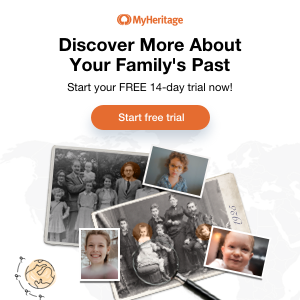Blog

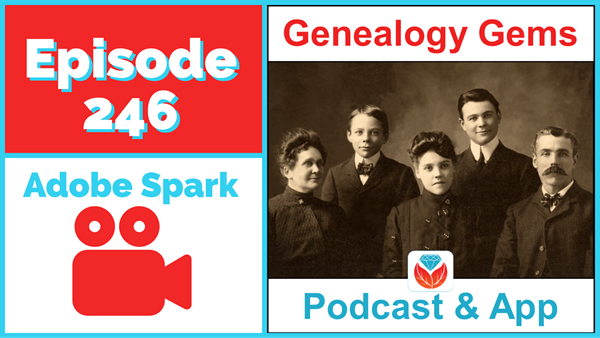
Genealogy Gems Podcast Episode 246
In last month’s episode we talked about how to construct a great family history story for video. Video is the perfect medium for sharing your family’s history. It captures the interest of the eyes and the ears.
In this episode I’ve got the ideal tool for you to use to make your video: Adobe Spark Video. Adobe Spark Video is a free app and website tool that makes it easier than ever to create shareable videos.
Click below to listen:
Genealogy Gems Podcast Episode 246 with Lisa Louise Cooke
October 2020
Watch the Companion Video & Get the Full Show Notes
This episode features the audio from Elevenses with Lisa Episode 16 – How to Make a Video with Adobe Spark. Watch the video and read the full show notes here.
After listening to this episode, watch Elevenses with Lisa episode 16 How to Make a Video with Adobe Spark to learn how to make videos quickly and easily for free.
Genealogy Gems Premium Members can download the handy PDF show notes for each of these Elevenses with Lisa episodes. Simply log into your membership, and then in the menu under “Video” click “Elevenses with Lisa.” Click the episode and scroll down to the Resources section of the show notes.
Become a Genealogy Gems Premium eLearning Member
Premium Members have exclusive access to:
- Video classes and downloadable handouts
- The Genealogy Gems Premium Podcast
- Elevenses with Lisa downloadable show notes PDF
Become a member here.
Getting Your Family History Digitized
I use Larsen Digital and have been extremely pleased with the service and results. The folks at Larsen Digital have put together special and exclusive discounts for Genealogy Gems listeners and readers. Click here to learn more and receive exclusive discounts and coupon codes.
Get Unlimited Photo Enhancement and Colorization at MyHeritage
Get genealogy records and unlimited Enhanced and Colorized photos as a MyHeritage PremiumPlus or Complete Plan Subscriber. Click here to start a free trial.
Follow Lisa and Genealogy Gems on Social Media:
Instagram.com/genealogygemspodcast
Facebook.com/genealogygems
Pinterest.com/lisalouisecooke
YouTube.com/GenealogyGems
Stay Up to Date with the Genealogy Gems Newsletter
The Genealogy Gems email newsletter is the best way to stay informed about what’s available with your Premium eLearning Membership. Click here to sign up today.
Podcast Resources
Download the episode mp3
Show Notes: The audio in this episode comes from Elevenses with Lisa Episode 16. Visit the show notes page here.
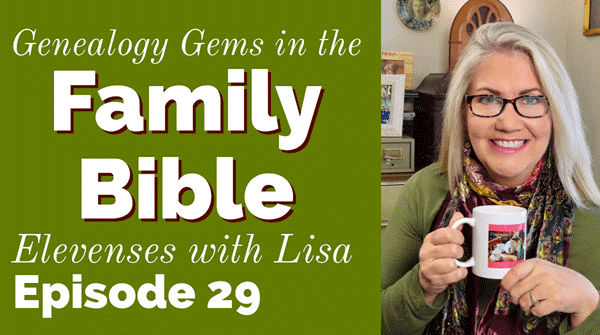
How to Find and Use the Family Bible – Premium
The Family Bible: Elevenses with Lisa Episode 29
The family Bible is an important resource for genealogy. Here’s how to find family Bibles and use them for family history.

Watch episode 29 of Elevenses with Lisa to learn how to find and analyze your family Bible for genealogy
Start by watching this video to learn how to find and use family Bibles. Then keep reading below for all of the website links and resources to help you be successful in your research of the family Bible.
Elevenses with Lisa, the online video series where we take a break, visit and learn about genealogy and family history.
Places to Look for the Family Bible
The best place to start looking is around your own house!
Where you Can Find Family Bibles Offline:
- Reach out to close family and distant cousins, particularly female lines
- Archives
- Historical societies
I reached out to my cousin Carolyn. She relayed a strange story to me about the family bible that was in my Great Grandmother Lenora Herring’s home:
The Strange Story
“Many years ago, probably when I was in my 20’s or 30’s I was visiting at the Herring home in Oklahoma. Lenora had already passed but Jewel (her daughter) still lived in the house.
I was asking her some questions about the family history. She got out the Bible and said it contained the only information she knew about. It was a large Bible – I don’t remember much about its condition – and getting pictures of things certainly wasn’t the trend. But she opened it up to the pages where the family history was written and she proceeded to tear out those pages and give them to me!

A page torn from the family Bible.
Looking back on that, I kinda wish I would have stopped her! So, she kept the Bible and gave me the family info pages! The Bible itself didn’t seem to impress me much. But I was very interested in what was written on those pages!
So after Jewel could no longer live in the Herring house and my mother placed Jewel in a nursing home, my mother disposed of all the things in the house and the house was sold to help pay for Jewel’s care. I was not there in Oklahoma when this occurred, but I guess Janette must have picked up the family Bible.
Eventually, Janette and I got our heads together and realized who had what. I’ve attached images of the family history pages. Some of it is hard to read – I think most of it was written in pencil. And for some reason, I didn’t make sense of some of the info till recent years.
I think there were multiple people that wrote on the pages – including my mother.
There was a Herring / Jump family reunion several years ago at the home of one of the Jump cousins. I went and so did Janette. She brought the family Bible to show. It was in very, very poor condition and if I remember right, stored in an old cardboard box……….”
Where You Can Find Family Bibles Online
Here’s a list of free websites where you can find digitized family Bibles.
Family Bibles at Library of Congress

Search for family Bibles at the library of congress
Internet Archive: Archive.org
Click here to see the search results for “family bible” at the Internet Archive.
The Streepy Bible is a great example of variation in handwriting.
Click here to see Genealogical records taken from the family Bible of James Monroe Palmer : born 1822, died 1897 and Caroline Frances Bacon, his wife, born 1830, died 1899 of Boston, Massachusetts.
A good example of a transcription of the records from a family Bible.
Ebay
Search for “family bible”. Try adding a surname.
Premium Members: Listen to my Premium Podcast episode 76 that includes strategies for using ebay for genealogy.
Google
Search for the surname along with the phrase family Bible using the quotation marks search operator. Example: “Cooke” “family Bible”
Resource for Google search strategies: The Genealogists’s Google Toolbox by Lisa Louise Cooke
FamilySearch
Search both the Card Catalog and the Digital Books collection for “family bible” and a surname.
In the Notes section of an item, you may find a link to click to view the digital version if one is available.
World Cat
Catalogs approximately 2 billion items from 10,000 libraries around the world.
Archive Grid
Includes “over 5 million records describing archival materials, bringing together information about historical documents, personal papers, family histories, and more.” Includes materials from over 1,000 different archival institutions.
Examining the Family Bible
- Check the title page
Is there a date that it was printed / published?
This may help you determine when it made its way into the family - Look through every page as things may be tucked in there.
- Look through the pages – look for markings. You may find passages that were particularly meaningful to them.
- Was the publish date after many of the dates entered into the Bible? There’s a chance the info may have been copied.
- Use a photo editor to preserve and even improve Bible pages. I use Snagit to invert the image. (Use our affiliate link for a 15% discount with our code GEMS15.) In the menu: Image > Effects > Filters > Invert. (Learn more about using Snagit for genealogy with my video and article How to Use Snagit for Genealogy.)
Interpreting the Family Bible
Here are questions to ask and things to consider as you interpret the contents of your family Bible for genealogy.
Was the information copied? If so, who then has the original? Keep in mind that mistakes could have been made during the copying or entered by memory.
Could the information have been recorded by people over time?
Is the handwriting all the same? If so, it’s more likely some copying.
Different handwriting in the family Bible may indicate more first-hand knowledge, or it may be someone filling in years later.
Analyze all of the entries. Like a scrapbook, there is significance to the order and each entry has significance. Is anyone missing?
Was there an incentive for inaccuracies? Was a marriage date fudged to hide a pregnancy before marriage?
Cross reference with other genealogical documents.
Did a wedding occur around the time of the Bible’s publication? The Bible may have been a gift.
Restoring the Family Bible
My cousin Carolyn had a large family Bible from her father’s side of the family restored.

The family Bible in need of restoration
“The woman who restored this Bible did an awesome job. She had available the correct restoration materials. It’s not perfect, like-new. But still very good.”
“She also did something to the leather to renew it in some way. When I first acquired the Bible, the brass latch would not close, but now it does! The Bible can now be viewed and handled (carefully, of course!) without it falling apart. She also constructed a special storage box for it, using archival quality materials.”
Since there wasn’t a restoration expert available in her area, she reached out to a book restoration expert in Indiana:
Leonard’s Book Restoration, LLC
“Website was helpful and they were pleasant to work with…They put a new cover on my own personal Bible, and I was very pleased with their work. A few years ago, I also had them re-do a small hardback Bible that my mother used. ”
Resources
Listen to the Genealogy Gems Premium Podcast Episode 68 on the Family Bible, Google Search
Rodney McCulloh shares his inspirational story of the path that he followed that lead him to the old family Bible.
Bonus Download exclusively for Premium Members: Download the show notes handout
Become a Genealogy Gems Premium Member today.
Answers to Your Live Chat Questions
One of the advantages of tuning into the live broadcast of each Elevenses with Lisa show is participating in the Live Chat and asking your questions.
From Sian: Is Archivgrid US-based only or worldwide?
From Lisa: It’s worldwide. In the “Search for a Location” list you can scroll down to see all the countries. You can also hover you mouse over the map and zoom out to see the full coverage.
From Kimberly: Hi from East Aurora NY. I can’t wait to take take another look at my grandmother’s Bible! Is it ok to add my information to her Bible?
From Lisa: While in the end, it’s a personal decision, I think it’s a wonderful idea to add information to the family bible. They are meant to be added to over generations.
Get My Free Genealogy Gems Newsletter
Click here to get my free weekly newsletter.
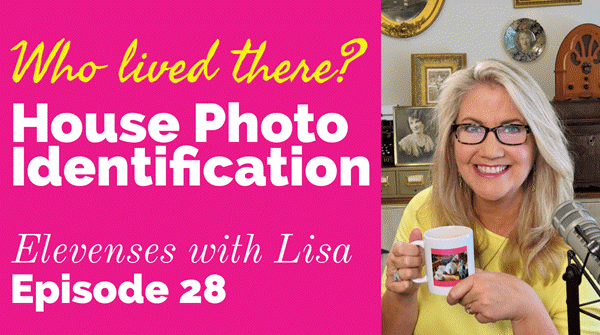
House Photo Identification – How to Find Who Lived at an Address
Elevenses with Lisa Episode 28
Original air date: 10/8/20
Join me for Elevenses with Lisa, the online video series where we take a break, visit and learn about genealogy and family history.

In this episode we’re going to take many of the things we’ve learned in past episode of Elevenses with Lisa and apply them to one of your genealogical problems. My goal isn’t to find the answer myself, but rather to provide a toolbox of strategies that you can use to experience the joy of the discovery yourself when researching a home or location, as well as in a wide variety of other genealogical situations! Keep reading for notes that accompany this episode.
Cynthia Owens is a regular viewer and participant in the Live chat each week during Elevenses with Lisa. She emailed this photo and wrote “This picture was with my mother’s belongings…photo of a house in Omak, Okanogan, Washington with only an address written on it. 308 S. Main, Omak, WA. I have hundreds of photo’s (B & W) that have no information on them and a lot of people who I don’t know. I have a gold mine and no idea how to mine it.”
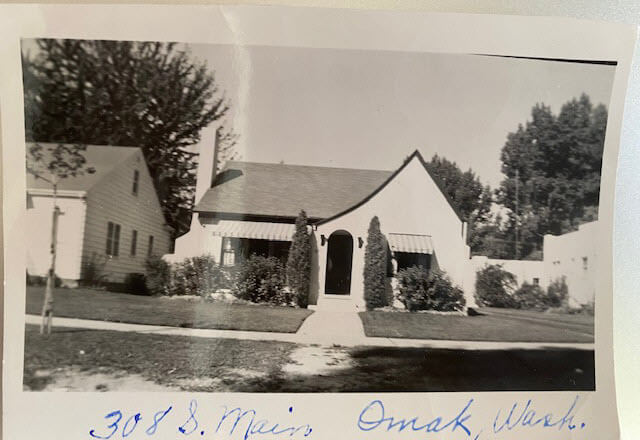
The house photo in Cynthia’s family collection.
Cynthia said that so far she has found the names of the last two owners in county records and some directories. She also determined that the house was built in 1928. She writes, “I have a lot of family on both sides of my parents who could have owned it.”
Formulate Your Research Question
The research question in this case boils down to: Who owned the home at 308 S. Main, Omak, WA in the 1930s?
Compile Known Family Names
We start by compiling a list of family surnames that we will be on the lookout for. These are families who are known to have lived in Washington state during that time frame.
Cynthia’s mother’s family names:
- Woodhead
- Patience
Cynthia’s father’s family names:
- Tucker
- Stubbs
- Tonks
Answer the Question Does the house still exist today?
To answer this question, we turn to the free Google Earth Pro software. By simply searching the for the address and using Street View we are able to determine that yes, it is. Google Earth also allows us to obtain a high-quality image.
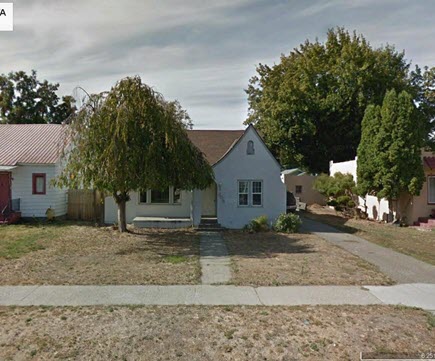
The house in Google Earth’s Street View today.
Google for Land Records
I conducted a simple Google search: Okanogan County Land Records
The results:
- The Central Regional Branch of the Washington State Archives
“The Central Regional Branch provides archival and records management services to local government agencies throughout Benton, Chelan, Douglas, Franklin, Grant, Kittitas, Klickitat, Okanogan, and Yakima counties.” - the Washington State Archives Digital Archives search page. Their online records don’t go back that far.
- The Okanogan County Auditor website
Locating Land Records
Special Guest: Kathy Nielsen, Librarian
Kathy Nielsen is a reference librarian and an educator. She has a masters degree in History and in Library Science. Kathy is currently a popular genealogy speaker on California’s Monterey Peninsula. She incorporates her skills as an historian, a storyteller and a librarian in her search for her family’s history. Kathy Nielsen stopped by to offer suggestions on obtaining land records. Watch Elevenses with Lisa episode 20 on House History featuring Kathy Nielsen.
The FamilySearch Wiki
Visit the free FamilySearch Wiki here. Search for the county in the wiki and then click on Land Records.
County Auditors Department
- Where land records are located.
- You can do a title search.
- The records may not be online.
- Email or call and inquire what the options are to access the records or have a search done.
- Access varies by county.
Follow the chain of ownership back in time:
Grantee = the person who bought the property
Grantor = the person who sold the property.
Real Estate Websites
- Trulia.com
- Zillow.com
These sites don’t provide owner names but do show you recent transactions.
Result: The house was sold in 1997. It went on the market briefly in 2013.
Assessor’s Office (Tax Records)
These are typically only available to the current owner.
More Places to Look for Real Estate Related Information
City Directories
City directories are usually published yearly. Look also for Reverse Directories that allow you to look up the address in order to find who lived there. Kathy suggests contacting the local public library staff to inquire about City Directories and other records. Many libraries are currently staffing online reference chat.
State Libraries
Kathy recommends expanding out from the local area library to nearby communities, and the state. The Washington State Library is also currently answering questions. They have a genealogy department and city directories.
WorldCat.org
WorldCat is the world’s largest network of library content and services. The online catalog that itemizes the collections of 17,900 libraries in 123 countries and territories.
National Register of Historic Places
According to the website: “The National Register of Historic Places is the official list of the Nation’s historic places worthy of preservation. Authorized by the National Historic Preservation Act of 1966, the National Park Service’s National Register of Historic Places is part of a national program to coordinate and support public and private efforts to identify, evaluate, and protect America’s historic and archeological resource.” Click here to learn more about and search their digital database.
Department of Archaeology and Historic Preservation (Washington State)
From the website: “On this site you will find information on historic buildings, the archaeology of Washington State, how to navigate our regulatory processes and how to nominate properties to the State and National Register of Historic Places.”
Neighbors
Contacting and talking to neighbors is often one of the quickest and easiest ways to gain information. The 411.com website offers a free reverse address lookup. The results will give you the name of the current owner and residents, and even plot nearby neighbors (with names) on a map.
Researching the Home from Home
If you’re unable to research in person, make significant headway with these online resources.
Historical Societies
Google to find the official website of the historical society located in the area where the house is located. These sites may include searchable databases and information on how to contact them for resources and lookups.
Result: The Okanogan County Historical Society features a searchable database.
Search Facebook for the name of the county historical society in the area where the house is located. Facebook pages often include more up to date information than the official website.
Old Maps
Depending on the town and area, you may be able to find an old map from the approximate time frame that includes details on homes. Two excellent free resources are:
- Davidrumsey.com
- Historical maps in the Layers panel of Google Earth Pro
Search at Genealogy Records Websites
Searching for various combinations of the address, town and surnames from the family tree may lead you to an answer. Here are a few examples of searches run at Ancestry.com and FamilySearch. (Your results may vary depending on the date you are searching):
Keyword: (address) 308 Main St, Omak (exact)
Results: 25 (These were not all exact)
Residence: (town) Omak (exact) and Keyword: (address) 308 Main St. (exact)
Results: 5
Search each surname in Okanogan County at Ancestry.
Results for Cynthia’s mother’s family names:
Woodhead (Paul Woodhead married in Okanogan in 1941)
Patience (No results)
Cynthia’s father’s family names:
Stubbs (results from the 1970s)
Tonks (None)
Tucker (8 results)
FamilySearch.org
Run the same at the free FamilySearch.org genealogy website. Search each surname with Omak (exact) & 1920-1940 (restricted to) U.S. On the day I searched, the only surname from the list with results was Tucker. Cynthia’s next step would be to compare the results to her known family tree.
Search the Census Specifically
You can search the census by using the search fields and using variations of names, town, county and specific address. If you don’t find the specific address that way, brown the records of the town, looking for addresses written in the left margin. At Ancestry, look for the link to a map of the location found in a census.
Results: 1930 Census: 104 West First St., Omak (Jess Tucker)
Use Google Earth to determine if the addresses found are the same today. Plot each finding on the map using placemarks.
Result: 1930 Census Address: 104 West First Street, Omak = not there today
A search in the 1940 for Jess Tucker found him still living with his mother. She was recorded as “Frances Write” living at 504 Main St., Omak, close to the house in question. When searching the census be sure to look at the pages on either side of the results page. In this case Jess is found on the next page living at “no number” as a renter at his mother’s home.
1940 Census Enumeration District Maps
Ancestry has a collection of 1940 Enumeration District Maps from the National Archives (where they can also be found here along with additional helpful search strategies.) Enumeration districts are geographic areas that were designed to allow an enumerator (the census taker) to visit every house in the district within a two-week time period. A month was allowed in more wide-spread rural areas. These maps vary in the amount of detail provided. They may or may not indicate house numbers.
Go the Ancestry Card Catalog and search for the 1940 Census Enumeration District Maps collection. In the search fields for this collection, enter the enumeration district number which can be found in the upper corner of the 1940 census page.
State Census
State Censuses were often conducted every ten years in years ending with “5” which makes them a great supplement to the U.S. Federal Census. They also sometimes include information not gathered at the federal level. Therefore, an important question to ask is “was a State Census taken in this approximate time period?”
Here’s a State Census list from the National Archives.
Results for Washington state: No state census taken after 1898.
Card Catalog Include Useful Unique Sources
Not all useful records will surface with a straight-forward search. Dig into the Card Catalog of your favorite genealogy records website to find unique and useful collections that may include addresses.
Example: Search the Ancestry card catalog for Okanogan County, WA
Found: Washington, Postmaster Indexes, Prior to 1965
Strategy: Browse the alphabetically organized Okanogan cards for each family name.
Another unique record type that often includes address are Draft Cards. Search by location then surname. Also try Keyword searches. Not all cards include complete addresses but many do.
The Future is Bright
Here’s a summary of the wide variety of genealogical research strategies we’ve covered in this episode:
- FamilySearch Wiki (by county)
- FamilySearch Card Catalog (by location)
- County Auditor’s Dept. for land records
- com for most recent purchase
- City Directories (including reverse)
- Local, County, and State libraries)
- org
- National Register of Historic Places
- Neighbors
- Historical Society (website and Facebook)
- Old maps
- Search Genealogy sites by address & surname
- Census / State Census
- Unique Records (Draft cards, Postmaster Index)
- Plot in Google Earth for perspective
- Census Enumeration District Maps
Resources
Premium Video & Handout: Solving Unidentified Photo Album Cases. (This video features using Google Photos.) Also watch Google Earth for Genealogy and download the handout.
Bonus Download exclusively for Premium Members: Download the show notes handout
Become a Genealogy Gems Premium Member today.
Please Leave a Comment or Question
I really want to hear from you. Did you enjoy this episode? Do you have a question? Please leave a comment on the video page at YouTube or call and leave a voice mail at (925) 272-4021 and I just may answer it on the show!
If you enjoyed this show and learned something new, will you please share it with your friends? Thank you for your support!



